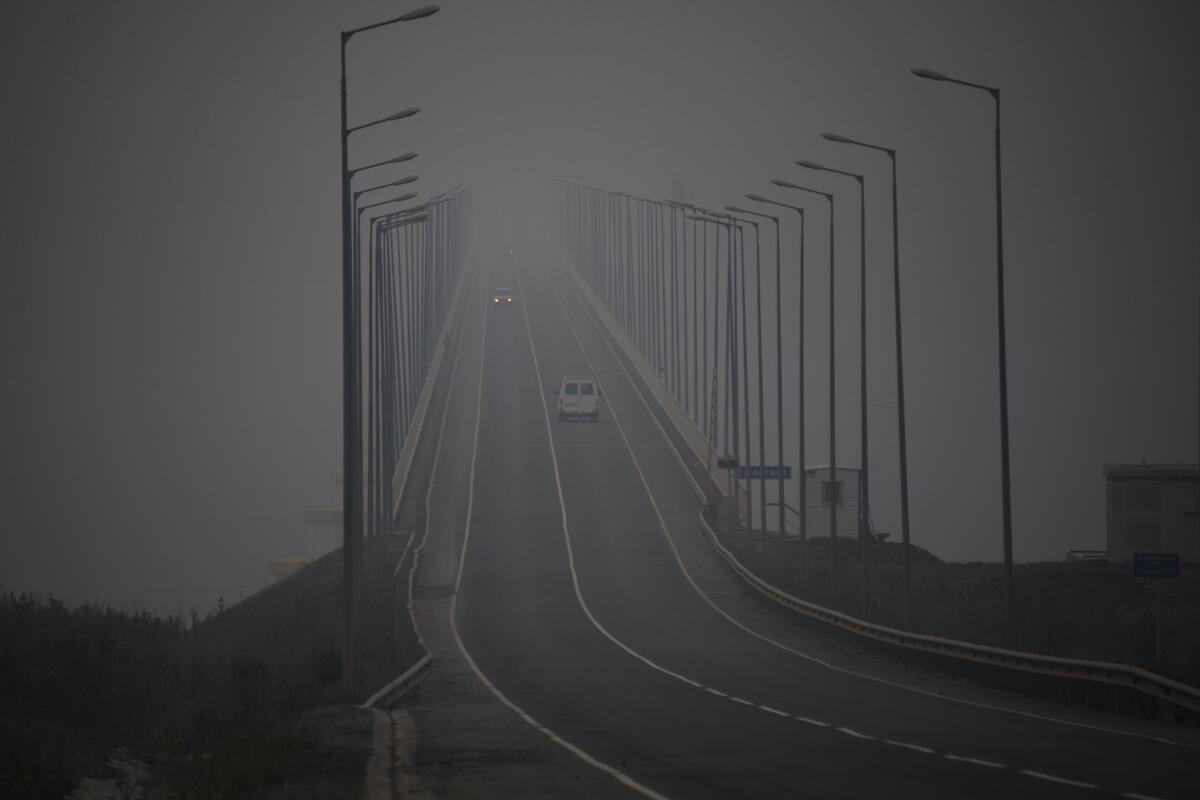Siberia just experienced wildfires on a staggering scale. Russia is rethinking how to fight them

- Share via
MOSCOW — Four years ago, Russia instituted a policy of letting remote forest fires burn unless it made sense economically to put them out.
Environmentalists warned that the new rules would intensify Siberia’s annual fire season and release more greenhouse gases into the air. The public, for the most part, didn’t pay attention to the regulation change.
That changed this summer when fires swept quickly through thousands of square miles of Siberian forest and strong winds spread smoke and ash across a third of the country.
For several days, dark clouds blanketed the cities of Novosibirsk and Krasnoyarsk — each home to more than a million people — hundreds of miles from the fires’ epicenter.
Siberians begged the government to ignore the cost efficiency regulations and extinguish the remote fires. Russian President Vladimir Putin finally sent in military planes and helicopters to douse the flames.
Now Prime Minister Dmitry Medvedev has ordered the government to examine the “control zone” burn regulations when parliament meets next month. A change in the policy could have far-reaching benefits in the fight against climate change.
Russia has the largest forested area in the world, covering about 45% of the country. Much of that forest is remote and difficult to reach, which creates unique challenges when battling fires, whether they are in the taiga forests of the Krasnoyarsk region or the Arctic tundra in the republic of Sakha.
The current regulation grants regional authorities the right to decide whether it is economically viable to extinguish a remote fire that does not directly threaten settlements or people. If the cost of putting out these remote fires is greater than the profit that could be made from selling the timber, they can decide to let it burn.
But critics say it is irresponsible simply to let remote fires burn, spread and pollute.
“When the law was drafted in 2015, it never occurred to anyone that the wind would be able to bring smoke from the fires so far,” said Andrey Sirin, director of the Institute of Forest Science at the Russian Academy of Sciences. “Often the damage to people’s health is much worse than the damage to the economy.”
In a petition to the Kremlin calling for a policy change, the environmental group Greenpeace said that “these forests are considered to be sufficiently accessible for logging, but they are also called inaccessible and therefore too hard to extinguish.”
Still, experts said that more aggressive firefighting would not solve the underlying issues: a failure of prevention efforts, a lack of sustainable forest management and hotter, drier conditions resulting from climate change.
“The problem is not only the fires this year,” said Anton Beneslavskiy, a forest fire expert with Greenpeace International in Moscow. “The problem is that these fires happen every year, and with more intensity. Previously it was one catastrophic fire a year. Now it’s a lot of them and in different parts of the world.”
This year’s fires in Siberia have been especially brutal.
According to Russian authorities, they have burned more than 11,500 square miles of Siberian forest, including areas north of the Arctic Circle.
Greenpeace disputed those figures, saying the burn area was nearly 21,000 square miles, or nearly three times the size of New Jersey.
The group estimates about 90% of the fires occurred in the control zones that the government is now reconsidering.
Rains and cooling temperatures in Siberia this month have helped keep the fires in check for the moment, but Greenpeace estimated in mid-August that only 9% had been extinguished and that by the end of the season the burn area could break the 2012 record of nearly 70,000 square miles.
It estimated that the fires had already released 138 megatons of carbon dioxide, more than the annual emissions of many countries.
In addition, scientists now believe intense forest fires around the world are increasingly emitting particles known as “black carbon,” which are carried by the wind and eventually settle on the earth. Some wind up on Arctic ice sheets, where they soak up sunlight and accelerate thawing.
Hundreds of this year’s Siberian fires were above the Arctic Circle, meaning more particles were expected to land on the ice sheets.
For centuries, starting in the era of czar Peter the Great, Russia cared for its forests through a system of government forest rangers. Often a ranger job would be handed down through generations of a single family.
The system meant close monitoring of forests and, Sirin said, allowed the rangers to quickly extinguish small fires.
But a 2006 law ended that system, relying instead on forest tenants, who cover territories 10 times the size of those the rangers monitored and who have very little power and few resources.
Beneslavskiy said Russia also needs systemic change to build a sustainable forest industry.
Russia is a global leader in forest depletion — a significant cause of global warming — in large part because of China’s seemingly insatiable appetite for Russian lumber.
Ayres is a special correspondent.
More to Read
Sign up for Essential California
The most important California stories and recommendations in your inbox every morning.
You may occasionally receive promotional content from the Los Angeles Times.














